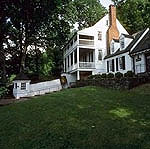RENEGADE GARDENER™
The lone voice of horticultural reason
The Myth of the 4-Step Fertilized Lawn
5-14-02 – Gaze out at an expansive, velvety grass lawn and one senses how it might be possible that such a great, green shag would require four applications of lawn fertilizer per season. And when major lawn fertilizer companies tell you in their advertising bombardments that fertilizing in four steps is the best way to care for a lawn, naturally many homeowners commit to following the 4-step program.
Except it isn’t true.
Research by the University of Minnesota shows that the best time to fertilize a Zone 5 through Zone 2 lawn is in the fall, starting around Labor Day. Follow it up with a second application in late October. That’s it.
 The research shows that early spring applications of nitrogen (the first number on the bag, and the macronutrient that gives lawn fertilizer its main wallop) stimulates shoot growth that depletes energy reserves in plant roots. Remember, the 4-step program includes fertilizing the fall before. Spring application of fertilizer is not only unnecessary, it does more harm than good.
The research shows that early spring applications of nitrogen (the first number on the bag, and the macronutrient that gives lawn fertilizer its main wallop) stimulates shoot growth that depletes energy reserves in plant roots. Remember, the 4-step program includes fertilizing the fall before. Spring application of fertilizer is not only unnecessary, it does more harm than good.
Why the misinformation? Industry avarice. Imagine the bounty created by the lawn fertilizer companies. They have eighty zillion Americans buying and using approximately twice as much lawn fertilizer per year as is needed. (It’s also true that even in the southern United States, two to three applications is plenty.)
What is equally upsetting is that the fertilizer companies never utter a word about incorporating a soil test into the equation. The proper ratio of nitrogen (N), phosphorus (P), and potassium (K) to apply to a lawn should be sternly dictated by such a test. By failing to express this most basic of horticultural principles to the public, lawn fertilizer manufacturers have been able to sell fertilizer for fifty years before a whistle was finally blown. In the past few years, the facts have come out: phosphorus levels in lawns are so high, you don’t need any more phosphorus in your fertilizer mix for a decade or more. (Phosphorus binds readily to the soil and builds up, unlike nitrogen or potassium.)
Nor do the fertilizer companies tell you that in areas of drought, the worst thing one can do is apply nitrogen to a lawn in spring, since it promotes leaf rather than root growth. The truth cuts into their sales and profits, and complicates the issue, and assumes that you might be willing or even able to learn a little about lawn culture.
Further, the species and varieties of grass should determine the level of lawn care, not a giant fertilizer company’s multi-million-dollar advertising budget. A low-maintenance, northern lawn of common types of Kentucky bluegrass and fescue benefits most from a single application of fertilizer in September. A medium-maintenance lawn only needs fertilizing twice, once in late August/early September and again in late October. High-maintenance lawns of the improved type of Kentucky bluegrass need the two late-season fertilizations, plus a late May application. Under no conditions does four applications of fertilizer improve lawn performance.
It’s all a sham. There are many recommendations created by the sales departments of various corporations within the gardening industry that prove false. However, the lawn industry is by far the worst. And remember, it takes a lot to set me off when it comes to bashing corporations. Those well-intentioned, earnest, typically under-clothed, socialist college students who knock on my door all winter, getting signatures and asking for donations to this cause and that, are always welcomed in by the Renegade Gardener.
Sometimes I even pull out my checkbook. Sometimes there is even money in the account. But whether they get any money from me or not, they don’t leave until they receive my free, two-minute lecture on how ninety-five percent of the big corporations in America are honest, ethical operations that provide benefit, and cause employment and spin-offs, because capitalism is a pure and wonderful thing.
Some corporations in the lawn industry, however, reside firmly in that repugnant, scandalous, evil five percent.
My thanks to Anoka County Master Gardener Jean Hjellming for her paper on this topic, parts of which are included in the above.
Don Engebretson
The Renegade Gardener